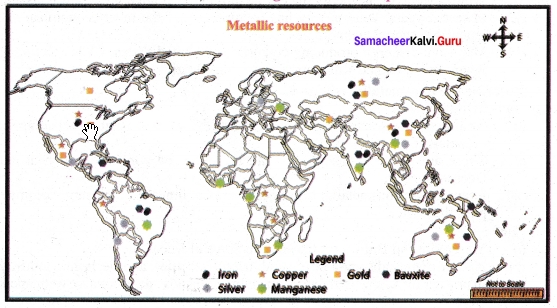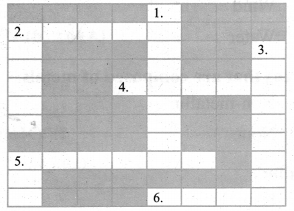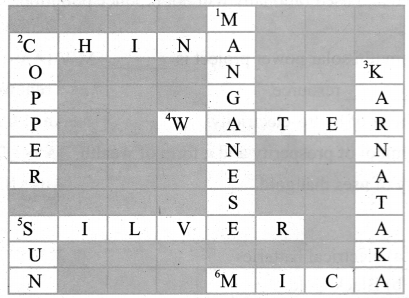You can Download Samacheer Kalvi 7th Social Science Book Solutions Guide Pdf, Tamilnadu State Board help you to revise the complete Syllabus and score more marks in your examinations.
Tamilnadu Samacheer Kalvi 7th Social Science Geography Solutions Term 2 Chapter 1 Resources
Samacheer Kalvi 7th Social Science Resources Textual Exercises
I. Choose the correct answer:
Question 1.
Which one of the following is renewable resource?
(a) Gold
(b) Iron
(c) Petrol
(d) solar energy
Answer:
(d) solar energy
Question 2.
Where is the largest solar power project situated in India?
(a) Kamuthi
(b) Aralvaimozhi
(c) Muppandal
(d) Neyveli
Answer:
(a) Kamuthi
Question 3.
Which is one of the first metals known and used by man?
(a) Iron
(b) Copper
(c) Gold
(d) Silver
Answer:
(b) Copper
Question 4.
_______ is one of the indispensable minerals used in electrical and electronics Industry.
(a) Limestone
(b) Mica
(c) Manganese
(d) Silver
Answer:
(b) Mica
Question 5.
Electricity produced from coal is called ________.
(a) Thermal Power
(b) Nuclear power
(c) Solar power
(d) Hydel power
Answer:
(a) Thermal Power
![]()
II. Fill In the blanks
- ______ is the largest producer of hydroelectricity.
- Iron ores found at ______ in Tamil Nadu.
- ______ is produced from bauxite ore.
- ______ is used in making electrical batteries.
- Petroleum and its derivatives are called ______.
Answers:
- China
- Kanjamalai
- Aluminium
- Manganese
- Black Gold
III. Match the following
Question 1.
- Renewable resource – Iron
- Metallic resource – Mica
- Non-metallic resource – Wind energy
- Fossil fuel – Sedimentary rock
- Limestone – Petroleum
Answers:
- Renewable resource – Wind energy
- Metallic resource – Iron
- Non-metallic resource – Mica
- Fossil fuel – Petroleum
- Limestone – Sedimentary rock
![]()
IV. Consider the following statement and tick (✓) the appropriate answer
Question 1.
Assertion (A): Wind power is Clean Energy.
Reason (R): Wind turbines do not produce any emissions
(a) A and R are correct and R explains A
(b) A and R are correct but R does not explain A
(c) A is incorrect but R is correct
(d) Both A and R are incorrect
Answer:
(a) A and R are correct and R explains A
Question 2.
Assertion (A): Natural gas is found with petroleum deposits.
Reason (R): it can be used as a domestic and industrial fuel.
(a) A and R are correct and R explains A
(b) A and R are correct but R does not explain A
(c) A is incorrect but R is correct
(d) Both A and R are incorrect
Answer:
(a) A and R are correct and R explains A
![]()
V. Answer the following
Question 1.
Define Resource.
Answer:
Anything which can be used for satisfying human needs is called a resource.
Question 2.
What are the uses of iron?
Answer:
- Iron is used to manufacture steel and also used in civil engineering like reinforced concrete, griders etc.
- It is used to make alloy steels like carbon steels with additives such as nickel, chromium, vanadium, tungsten, and manganese.
Question 3.
What are the major utilizers of solar energy in the world?
Answer:
India, China, Japan, Italy, and the States of America are major utilizers of solar energy in the world.
Question 4.
Name the types of coal-based on carbon content.
Answer:
Coal is classified into four types based on carbon content. They are:
- Anthracite
- Bituminous
- Lignite
- Peat
Question 5.
Give a short note on Duralumin.
Answer:
Duralumin is an alloy, a trade name given to the earliest types of the age hardenable aluminum alloys. It is an alloy made up of 90% aluminum, 4% copper, 1 % magnesium and 0.5% to 1 % manganese. Duralumin is a hard, but lightweight alloy of aluminum.
![]()
VI. Distinguish the following
Question 1.
Biotic resources and abiotic resources.
Answer:
Biotic Resources:
- Biotic resources are found in the biosphere obtained from living and organic materials.
- It includes forests, crops, birds, animals, fishes, and fossil fuels.
Abiotic Resources:
- Abiotic resources come from nonliving non-organic material.
- It includes land, water air, sunlight, gold, copper, silver, etc.
Question 2.
Renewable resources and non-renewable resources.
Answer:
Renewable resources
- A renewable resource is used repeatedly and replaced naturally.
- It will not produce pollution.
- Ex. solar energy, wind energy and hydropower.
Non-Renewable resources
- Natural resources that once consumed and cannot be replaced is called non-renewable resources.
- Continuous consumption leads to exhaustion.
- Ex. Fossil fuels coal, Petroleum, natural gas and mineral resources iron, copper bauxite, gold, silver etc.
Question 3.
Metallic resources and non-metallic resources.
Answer:
Metallic resources
- Metallic resources are composed of metals.
- These are hard substances and good conductors of heat and electricity.
- Ex. iron, copper, gold, bauxite, silver, manganese etc.,
Non-Metallic resources
- Non-metallic resources do not comprise of metals.
- These are not hard substances and are not good conductors of heat and electricity.
- Ex. Mica, limestone, gypsum, dolomite, phospate etc.
![]()
VII. Give reason
Question 1.
Aluminium has wide range of uses compared to other metals.
Answer:
- Aluminium has a wide range of uses compared to other metals.
- Because Aluminium is light in weight, tough and cheaper.
- It is used in the construction of aircraft, ship, automobiles, Railway coaches etc.
- It is a good conductor of electricity and heat. So it is used for making electrical cables.
Question 2.
Water is considered a great source of energy.
Answer:
- Water is considered a great source of energy.
- It is used for producing hydro-electric power.
- It is used for drinking, bathing, and Hydroelectricity.
- Without water, all living things should not live.
- So it is considered a great source of energy.
![]()
VIII. Answer in a paragraph
Question 1.
Explain the different types of renewable resources.
Answer:
- A renewable resource is used repeatedly and replaced naturally. It will not produce pollution.
- Ex: Solar energy, Wind energy and hydropower.
Solar energy:
- Solar energy is the energy in the form of heat and light Produced by the sun.
- It is not harmful to the environment.
- Photovoltaic devices or solar cells, directly convert solar energy into electricity.
- India, china, Japan, Italy and the USA are the Major utilizers of solar energy.
Wind energy:
- Wind energy is one of the most economical energy technologies.
- Modem wind turbines with three blades turning wind into electricity.
- USA, China, Germany, Spain, India, UK, Canada, and Brazil are the major wind energy-producing countries.
Hydropower:
- Hydroelectricity is generated from moving water with high velocity and great falls with the help of turbines and dynamos.
- China, Canada, Brazil, USA, Russia, India, Norway and Japan are some countries producing hydroelectricity.
Question 2.
Describe the non-metallic resources.
Answer:
- Non-metallic resources do not comprise of any metals.
- They are good conductors of heat and electricity.
- Example: mica, limestone, gypsum, dolomite, phosphate etc.
Mica:
- Muscovite and Biotite are the common ores of Mica.
- It is used in electrical and electronics industry and used for making lubricating oils and decorative wallpapers.
- China, Russia, Finland, USA, Turkey and Korea are the leading producers of mica.
Limestone:
- Limestone is a sedimentary rock composed by skeletal fragments of marine organisms.
- It is used for facing stone, floor tiles, stair treads, windows sills.
- It is also used in smelting and metal refining process and portland cement production.
- China, USA, India, Russia, Brazil and Japan are the leading producers of limestone. Tamil Nadu produce over 3/4 of total limestone in India.
Question 3.
What are the different types of fossil fuel resources? Explain them.
Answer:
- Fossil fuel resources are formed from the remains of dead plants and animals.
- It is formed from hydrocarbon. Ex: Coal, petroleum, and natural gas.
Coal:
- Coal forms when dead plant matter is converted into peat. Electricity produced from coal is called ‘Thermal power’.
- It is classified into 4 types based on carbon content.
1. Anthracite 2. Bituminous 3. Lignite 4. Peat - The leading coal producers of the world is China.
Petroleum:
- Petroleum is found between the layers of rocks and is drilled from oil fields located in coastal areas.
- It produces a variety of products like diesel, petrol, kerosene, wax, plastics, and lubricants. It is called Black Gold. The chief petroleum-producing countries are Saudi Arabia, Iran, Iraq, and Qatar.
Natural Gas:
- Natural gas is found with petroleum deposits. It can be used as a domestic and industrial fuel.
- The natural gas reserves found in the USA, Russia, Iran, and Qatar.
![]()
IX. Activity
Question 1.
Mark the metallic resources on the given outline map of the world.

Question 2.
Crossword puzzle

Across:
2. The leading coal producers of the world
4. Considered as a great source of energy
5. Precious metal like gold
6. Used as an insulating material in the electrical industry
Down:
1. Used in making electrical batteries
2. Good conductor of heat and electricity
3. The largest producer of gold in India
5. Produces energy in the form of heat and light

![]()
Samacheer Kalvi 7th Social Science Resources Additional Questions
I. Choose the correct answer:
Question 1.
______ are the non-living parts of an environment.
(a) Biotic resources
(b) Abiotic resources
(c) Both
(d) None
Answer:
(b) Abiotic resources
Question 2.
______ is not harmful to the environment.
(a) Sotar energy
(b) Wind energy
(c) Hydropower
(d) None of these
Question 3.
Kamuthi solar power project is situated in ______ district in Tamil Nadu.
(a) Madurai
(b) Tirunelveli
(c) Ramanathapuram
(d) Kancheepuram
Answer:
(c) Ramanathapuram
Question 4.
______ ¡s considered as a great source of energy.
(a) Air
(b) Wind
(c) Land
(d) Water
Answer:
(d) Water
Question 5.
_______ resources are the type of resources that are composed of metals.
(a) Metallic
(b) Non-metallic
(c) Both
(d) None
Answer:
(a) Metallic
Question 6.
Iron ores found at _______ in Tamil Nadu.
(a) Shervaroy hills
(b) Kanjamalai
(c) Palani hills
(d) None of these
Ans:
(b) Kanjamalai
![]()
II. Fill in the blanks:
- _________ are resources that exist without the action of humankind.
- _________ resources harvested and used rationally will not produce pollution.
- The installed capacity of the Kamuthi solar power project is _________ MW.
- Hydro electric power is a _________ resource.
- _________ is the largest producer of hydro-electricity.
- _________ is regarded as a symbol of prosperity and a form of wealth.
- _________ has a wider variety of uses that gold.
Answers:
- Natural resources
- Renewable
- 648
- Renewable
- China
- Gold
- Silver
![]()
III. Match the following:
- Gold – (a) electrical batteries
- Silver – (b) Black Gold
- Manganese – (c) Sedimentary rock
- Petroleum – (d) Mexico
- Limestone – (e) China
Answers:
- e
- d
- a
- b
- c
![]()
IV. Consider the following statements: Tick the appropriate answer
Question 1.
Assertion (A) : Fossil fuel resources are normally formed from the remains of dead plants and animals.
Reason (R) : They are often referred to as fossil fuels and are formed from hydrocarbon.
(a) A and R are correct and R explains A
(b) A and R are correct but R does not explain A
(c) A is incorrect but R is correct
(d) Both A and Rare incorrect
Answer:
(a) A and R are correct and R explains A
Question 2.
Assertion (A) : Mica is used as an insulating material in the electrical industry.
Reason (R) : Non-metallic resources are hard substances, and are good conductors of heat and electricity.
(a) A and R are correct and R explains A
(b) A and R are correct but R does not explain A
(e) A is incorrect but R is correct
(d) A is correct but R is incorrect
Answer:
(d) A is correct but R is incorrect
![]()
V. Answer in one or two sentences
Question 1.
What are the importance of resources?
- Natural resources satisfy the daily needs of man such as food, clothing, and shelter.
- Natural resources also contribute immensely to boost up a nation’s economy.
Question 2.
What is renewable resources?
Answer:
A renewable resource is a resource which can be used repeatedly and replaced naturally. Renewable resources harvested and used rationally will not produce pollution. The use of renewable resources and energy sources is increasing worldwide.
Example: solar energy, wind energy, and hydropower.
Question 3.
Write a note on Kamuthi Solar Project.
Answer:
Kamuthi solar power project is one of the largest solar power projects in the world. It is situated in Ramanathapuram District in Tamilnadu. The Kamuthi solar power project was completed on 21st September 2016. The installed capacity of this project is 648 MW.
Question 4.
Describe the major wind farms in India.
Answer:
Wind Forms:
- Muppandal
- Jaisalmer
- Brahmanvel
- Dhalgaon
- Damanjodi
Question 5.
What are Non-renewable resources?
Answer:
Natural resources that once consumed and cannot be replaced are called non-renewable resources. Continuous consumption of non-renewable resources ultimately leads to exhaustion. Examples of non-renewable resources include fossil fuels such as coal, petroleum, natural gas, and mineral resources such as iron, copper, bauxite, gold, silver, and others.
Question 6.
What are the types of Non-renewable resources?
Non-renewable resources can be divided into three types. They are:
- Metallic resources
- Non – Metallic resources
- Fossil fuel resources
![]()
VI. Answer the following in detail
Question 1.
What are the types of resources on the basis of origin?
Answer:
On the basis of origin, resources may be divided into two types. They are:
- Biotic resources
- Abiotic resources
1. Biotic resources:
Biotic resources are found in the biosphere which are obtained from living and organic materials. It includes forests, crops, birds, animals, fishes, man and materials that can be obtained from them. Fossil fuels such as coal and petroleum are also included in this category because they are formed from decayed organic matter.
2. Abiotic resources:
Abiotic resources are the non-living parts of an environment. Examples of abiotic resources include land, water, air, sunlight and heavy metals including ores such as gold, iron, copper, silver etc.
Question 2.
Briefly explain any four of the metallic resources.
Answer:
Metallic resources are the type of resources that are composed of metals. These are hard substances, which are good conductors of heat and electricity. Examples for metallic resources are iron, copper, gold, bauxite, silver, manganese, etc.
Iron: Iron is the fourth most common element in the Earth’s crust and the most widely available metal. Magnetite and hematite are the common ore for iron, which occurs normally in the rocks of the crust.
Copper: Copper is one of the first metals known and used by man. Copper ranks as the third most consumed industrial metal in the world after Iron and Aluminium. Copper is a good conductor of heat and electricity. Chile is the world’s number one country in the production of copper.
Gold: It is a rare and precious metal. Hence, it has a high demand in world markets. Formerly, it was used for minting coins, but now it is used for making ornaments and in dentistry. It is regarded as a symbol of prosperity and a form of wealth. China is the world’s largest producer of gold.
Silver: Silver is also a precious metal like gold. It has a wider variety of uses than gold. It is used in making jewellery, dentistry, photographic goods, the electroplating industry, and in the manufacture of luxury goods. Mexico is the world’s leading silver producer.
![]()
VII. Give reason.
Question 1.
Manganese is used in drafting electrical batteries.
Answer:
Manganese is used in making electrical batteries. It is also used as colouring material in bricks, pottery, floor tiles.
Question 2.
Silver is also a precious metal like Gold.
Answer:
Silver is also a precious metal like gold. It has a wider variety of uses than gold. It is used in making jewellery, dentistry, photographic goods, the electroplating industry, and in the manufacture of luxury goods.